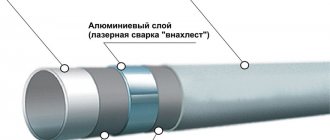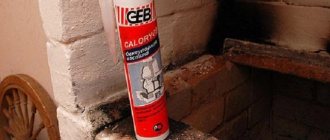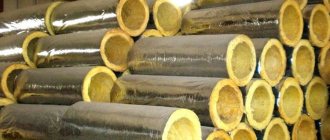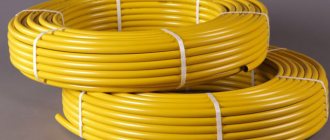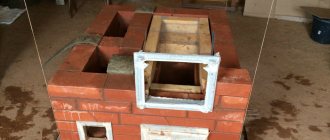The service life of a fireplace or stove largely depends on how and with what exactly the chimney is sealed using stainless steel or other materials.
Correct installation does not guarantee the absence of problems with combustion products entering the room. Over time, pipe materials are subject to thermal deformation, which leads to ruptures and cracks in the structure.
This leads to a decrease in draft, as a result of which a large volume of combustible material is required to heat the house, and because of this, soot intensively settles on the inner surface of the pipe. The latter is especially dangerous, as it not only leads to the formation of condensation, but can also cause a pipe fire.
For this reason, for the stable functioning of a chimney made of stainless steel or any other materials, it must be regularly inspected and any deficiencies that may arise must be promptly corrected. To avoid problems in the future, it is better to seal all cracks and joints to avoid defects.
The construction market offers a wide range of sealing agents: based on silicone, bitumen, silicate and acrylic. The entire wealth of choice is conventionally divided into heat-resistant and heat-resistant sealing agents, although, of course, there are many more varieties.
Why do you need chimney sealing?
The chimney is designed to remove hot combustion products from the combustion chamber of a heating unit - boiler, stove, fireplace. When any fuel is burned, it produces a lot of carbon dioxide (CO2), a small amount of carbon monoxide (CO), sulfur oxide (SO2), a small amount of oxides of some other elements, water, and unburnt fuel particles (soot). All of them are harmful to humans.
Hot water can increase the humidity in the room and lead to the formation of streaks on the walls and ceiling. Soot and soot stains can ruin the finishing of a room.
The temperature of the exhaust gases from solid fuel boilers can reach 600 °C and above, from gas boilers - 200 °C, when cleaning the smoke hog by igniting soot it reaches 1000 °C. A small stream of hot gas from a chimney is a common cause of fire. Even 200 °C for a long time is enough for the wallpaper to begin to smolder.
Therefore, the tightness of the chimney is a prerequisite for its operation. Modern heat-resistant sealants are used to seal the joints of individual elements of prefabricated chimneys. In addition, they are used for emergency sealing of leaks that occur during the heating season, when it is not possible to turn off the heating device and disassemble and replace part of the chimney.
Heat-resistant sealants are even used to seal holes and cracks in traditional brick chimneys. Traditionally, clay was used for this, but it is unreliable as a sealant. In addition, heat-resistant sealants are used to waterproof the exit of chimneys to the roof - this protects the rafters and under-roof structures from getting wet and rotting.
The best manufacturers
It is better to buy products from trusted manufacturers - their quality is usually higher. The low price should alert you - heat-resistant products cannot be too cheap. Otherwise, organic substances may be added to reduce the amount of silicone. The strength of such a material will be much lower, as will its elasticity.
The following brands have proven themselves well:
- Moment Germent High Temperature. Withstands up to +315 degrees, can be used for car repairs, heating systems, perfectly fills grooves and cracks, suitable for metal, wood, stone, glass, plastic.
- ABRO. Sealants from this company are sold in a large assortment, of different colors, with different technical characteristics. Within a few seconds, the products create gaskets with the highest strength.
- Foamed. The Estonian brand produces a material for filling seams and cracks that can withstand up to +1500 degrees of heating.
- Macroflex. Fireproof sealants of this brand are used for joining parts and repairing defects on products with low mobility, since the connection will be rigid. Withstands temperatures of +1200…+1500 degrees.
Soudal, Krass, and Titan sealants are also famous for their excellent quality. All these means can eliminate the need for expensive repairs or reinstallation of stoves and fireplaces. If you strictly follow the instructions, you can get a reliable connection by doing all the work yourself.
Types and differences
All types of sealants for use at high temperatures are divided into two large groups - heat-resistant (silicone) and heat-resistant (silicate). They differ in chemical composition and permissible operating parameters.
Heat resistant
Heat-resistant sealants are made on the basis of silicones - organosilicon oxygen-containing compounds. They can withstand temperatures up to 300 °C; at 100 °C and above, heat-resistant silicones are superior to all traditional elastic materials.
Silicones are durable, elastic, chemically inert, waterproof, resistant to biological influences, and ultraviolet radiation. They can operate under rapid temperature changes, are non-toxic, and environmentally friendly.
Heat-resistant silicones are available in the form of a reddish-brown paste. The color of the sealant is given by iron oxides. Operating temperatures can range from 170 to 300 °C, this information is indicated on the packaging.
Areas of application of silicone: sealing the outer surfaces of a chimney, the junction of a pipe and a roof, sealing blind cracks on brick surfaces of fireplaces and stoves, sealing pipes of gas boilers with high efficiency and low heating of flue gases.
The great advantage of heat-resistant sealants is their elasticity. Seam thickness is up to 6 mm, polymerization time is up to 20 minutes. Compaction work is carried out at positive temperatures (but not higher than 40 °C).
Silicone seals
For the convenience of consumers, the industry produces a huge range of silicone seals - gaskets, membranes, cords, tubes, seals of various configurations. They are used for sealing windows and doors, in household appliances, cars, and electrical equipment.
Master flush is made from silicone - an elastic seal for the passage of pipes through the roof. They produce special heat-shrinkable tapes - they are used to wrap the joints of chimney modules; when heated, they melt and tightly fill the joint being sealed.
Heat resistant
To seal and repair the internal surfaces of chimneys, combustion chambers, solid holes in brick pipes, joints of cast iron and steel elements with the furnace masonry, assemblies of sandwich chimneys, fire-resistant silicate polymers are used that can withstand temperatures up to 1200 °C (for a short time - even up to 1500 °C ).
Silicate sealants have a black or black-gray color and a viscous consistency, and harden within 15 minutes after application. The thickness of the seam can reach 15 mm. Heat-resistant silicates form an inelastic joint. Work is carried out at temperatures from 1 to 40 °C.
Silicates have good adhesion to metal, even stainless steel.
Adhesive facing compositions
The industry produces special heat-resistant compounds for cladding stoves, fireplaces and chimneys with tiles (regular, fireclay, clinker, porcelain stoneware), natural or artificial stone. They are usually made on the basis of silicates and contain liquid glass, kaolin, cement, plasticizers, and polymers.
Such mixtures can withstand temperatures from -30 to +170 °C and even higher. Other high-temperature adhesive compositions are also used in industry, the drying of which requires strong heating, but they are not widespread in everyday life.
Which type is better
Each type of sealant is designed for specific operating conditions and specific functions. Silicones are used on the outer surfaces of chimneys, stoves and fireplaces, sealing pipe elements of gas boilers. Heat-resistant silicate polymers are used in any case if the area where the sealant is applied is heated to more than 300 °C. They can also be used to seal leaks in heating units, even for metal.
Adhesive facing compounds are used for lining stoves and chimneys with ceramic tiles or stone. They are also used for heated floors and kitchen aprons.
Let's outline the scope of application
Construction supermarkets sell many sealing pastes used in heating, plumbing and sewerage systems. You must understand that ordinary food and plumbing sealants are not high-temperature, although they are used for installing some elements of chimney pipes.
Deep cracks can be sealed with mortar, but it is better to fill them with heat-resistant sealing paste
Water- and heat-resistant sealants are used for steel stoves, masonry, and fireplace repairs. Application options:
- Sealing cracks and holes in the walls of a combustion chamber built of brick or welded metal.
- Sealing chimney pipes during repair or installation.
- Exterior finishing of brick fireplaces and stoves.
- Bonding heat-resistant gaskets (asbestos and graphite-asbestos cords) to metal fittings - doors, valves, iron ovens and cast iron stoves.
- Waterproofing of roof junctions with chimneys made of metal and brick.
Note. Some repair compounds are even used to restore refractory masonry made of fireclay bricks. One condition: the maximum temperature in the firebox is 1500 °C.
A crack in the stove masonry or welded joint of a steel firebox leads to smoke in the heated room and the formation of soot in the defect area. The traditional way to eliminate it is to move the stove or cover the through gap with clay. Modern high-temperature sealant allows you to solve the problem much faster and more efficiently.
A cracked brick chimney often needs to be rebuilt
The suction of street air into the chimney pipe is a very unpleasant phenomenon. More condensation and soot fall on the walls, which can ignite at any time due to the high temperature of the flue gases. Hence the need arises to seal the connections between the chimney elements. We will discuss other methods of application in detail during the review of repair compositions.
Tips on how to choose
Heating equipment and chimneys are a very important and unsafe part of the home’s engineering. The life and health of residents depends on their serviceability. Therefore, it is not worth saving on heat-resistant sealants. It is best to buy materials from well-known brands and in large stores with a receipt.
Silicone is expensive and is sometimes counterfeited. If you purchased several bottles, you can squeeze out a little polymer from one, wait for it to cure and set it on fire. Silicone is difficult to burn and will produce a mixture of black and white soot (hydrocarbons and silicon oxide). A fake (most often acrylic polymers and PVC are used) will burn and release black soot.
It is also worth mentioning that heat-resistant sealants for stoves and chimneys are sold in tubes for a construction gun. If sellers recommend polymer in regular tubes, know that most often this is a sealant for cars, it contains acid and is completely unsuitable for heating equipment and chimneys, so before purchasing, carefully read the labels on the packaging.
When choosing, be sure to read the label. The operating temperature must correspond to the operating conditions; this is the most important criterion for choosing a heat-resistant sealant for a chimney. The sealant must be neutral, not acidic.
Popular brands
Popular brands of heat-resistant sealants are the Baltic Penosil (silicate, 1500 °C), the Belgian company Makroflex (silicone, 260 °C), the Belgian brand SOUDAL C (silicate, 1500 °C), Kraftool (silicate, 1500 °C), the domestic “Moment” Germent" (silicone). You can also mention affordable brands of silicate compounds BAUMASTER and TITAN (Selena Group).
approximate price
Below is information on how much the most common brands of heat-resistant polymers cost. Silicone polymers are much cheaper than silicate ones.
Types of high-temperature sealing substances according to release form
Manufacturers mainly produce oven sealants for household use in tubes. They are used together with a construction gun. Manufacturers offer formulations in small tubes especially for treating small areas. The sealing material is squeezed out of them by simply pressing.
More often, single-component sealants are used for stoves and chimneys in residential buildings. They are used without any prior preparation. Such compositions require more time to dry compared to two-component substances. This allows you to correct errors made during installation.
Manufacturers produce two-component sealants in the form of a set consisting of a paste and a hardener. The components of the sealing material are mixed in accordance with the proportions specified in the instructions.
A two-component sealing agent is used in industrial facilities Source ad-cd.net
How to carefully and correctly apply sealant
When working with both types of polymers, it is necessary to prepare the surface of the chimney: clean, remove dust and dirt, and degrease. It is advisable to sand the steel with fine sandpaper to improve polymer adhesion.
The surface under the heat-resistant sealant must be completely dry. The tube is inserted into the gun and a small amount of silicone is squeezed onto the joint to be sealed. Allow to harden (approximate time is indicated on the package).
The base for the heat-resistant silicate polymer is prepared and slightly moistened. Apply the sealant and let it harden. Excess heat-resistant mass is removed before the sealant hardens. You can apply masking tape along the joint in advance and remove it after application.
It is advisable to carry out work in warm weather.
Features of sealing sandwich chimneys
Sandwich pipes have a metal surface. Both silicate and silicone polymers are used to seal them.
A characteristic feature of sealing sandwich pipes is the need to seal both the inner and outer pipes. In addition to the general safety considerations that were given at the beginning of the article, it is very dangerous for a sandwich to get atmospheric moisture from the outside or condensation from the inside into the insulation.
If the insulation (mineral wool) gets wet and freezes, the pipe can rupture and quickly rust. Aggressive acids will corrode even a stainless steel pipe over time.
The outer layer should be coated with silicone - it has excellent hydrophobic properties. For the internal joint, a heat-resistant sealant is selected depending on the type of heating device and the smoke temperature.
The sealing process itself is not particularly difficult - a bead of sealant is applied to the joining surfaces of the outer and inner layers and carefully spread with a layer of 1-2 mm using a spatula or a flat steel plate, then the chimney modules are joined together.
Algorithm for choosing a suitable tool
Knowing the properties and recommended scope of application of various compositions of high-temperature sealants, it will not be difficult to make the right choice.
So, attention should be paid to the following parameters:
- operating temperature;
- environmental friendliness;
- brand name.
Temperature endurance. The indicator depends on the base of the sealant - silicone or silicate. When choosing, it is necessary to compare the upcoming operating conditions of the paste with the values of the maximum permissible temperature.
For repairing fireboxes, sealing chimneys, combustion chambers, sealing cracks near doors and other stove fittings, only a fire-resistant composition with a maximum permissible temperature is suitable
If you save money and purchase a cheaper analogue, the components will simply burn out over time - the mineral filler will delaminate and you will have to repair the heating device again.
Environmental friendliness. The composition should not contain substances that release toxic volatile compounds when heated. Regular inhalation of such vapors has a negative impact on human health.
To protect yourself, it is better to refrain from purchasing goods from unknown manufacturers at a suspiciously low price. You need to carefully examine the packaging - counterfeits often contain spelling errors, and the text itself may be printed illegibly.
If you suspect a counterfeit, you must ask the seller for a quality certificate and accompanying document. It is better to buy sealant in specialized stores or large construction markets.
Manufacturer company. Among the wide assortment, domestic and foreign ones have won the trust of buyers: MasterTeks , Penosil , Kraftool , Alteco , Tytan , Soudal , Makroflex , etc.
Cement
Sealing a chimney with cement has been a long-forgotten method since the last century. However, it is still used today. The binding agent in this case is an asbestos-cement mixture in a 1:1 ratio.
The mixture is prepared by hand as follows:
- I fill the asbestos with water and bring it to a homogeneous mass;
- A homogeneous and swollen mass of asbestos is mixed with a portion of cement;
- The mixture is coated with the joint between the roof and the chimney;
- Operation of the chimney system is possible after the sealing mixture has completely dried.
Is tightness really necessary?
Brick stoves and fireplaces can crack due to uneven heating of the masonry, including if there is no protection with a layer of plaster or tiles. If through gaps appear in the design of the heating equipment, this entails not very pleasant consequences. Namely:
- Fuel consumption increases as the oxygen supply becomes larger.
- Soot can penetrate into living rooms and settle on the walls and ceiling.
- Combustion products, primarily carbon dioxide, enter the rooms, which can negatively affect human health.
Cracks in brick smoke exhaust ducts and cracks in a metal pipe for removing combustion products make the draft lower, while the heating structure is unable to function normally. This affects the fact that the fuel is burned at lower temperatures and produces a lot of ash, and more soot settles on the inside of the chimney pipe.
A lot of soot and a leaky chimney is a rather dangerous combination. Due to the penetration of air, the soot flares up, and it burns at temperatures above 1500 ° C, and causes the smoke exhaust ducts to heat up. A thin layer of high-temperature sealant does not prevent wood structures from charring, which creates a serious risk of fire.
In the case of gas boilers, cracks in the chimney pipe cause the burner to go out. To avoid regular checks of the boiler's performance, leaks in the chimney are sealed with a special sealant.
Even when installing sandwich-type chimneys, the joints of the sections should be sealed with high-temperature sealant. But the sealing agent must be applied carefully so that in the future it will be possible to separate the sections and carry out dismantling if necessary without consequences.
Processing options
In the field of maintenance and restoration of chimney ducts, traditional materials have long ceased to be relevant. They are being replaced by polymer-based products. With their help, sealing a stainless steel chimney becomes as reliable as possible and maintains the result obtained over a long period of operation.
Chimney treatment can be done in two ways.
The first method involves applying PEK-1 paste, made on the basis of diane epoxy resin, which can be converted into a polymer having a spatial, network structure, onto the inner walls of metal pipes. The paste turns into a solid if a special hardener made using an aromatic polyamine is used when performing work.
What to look for when looking for sealant
When choosing a sealant, the following points must be taken into account:
- Operating conditions of the heating device;
- Location of the joint or seam (inside the pipe, outside the chimney or on the roof);
- Temperature regime of the treated surface: Heat-resistant agents are mainly used to seal chimneys
- Consistency and composition of the sealant: solid silicone is best used for cracks in brickwork;
- Material for the manufacture of chimney elements.
A properly selected sealant will save you from unexpected expenses for cleaning or disassembling the chimney installation.
Installation technology for corrugated stainless steel pipes
It should be noted that the installation of corrugated pipes is a simple process. Thanks to the variety of types of fittings, it is quite possible to assemble any system yourself, without the involvement of specialists. The main thing is to follow the sequence of technological steps during the installation process and the correctness of the work performed, which will ultimately allow you to obtain a strong, reliable and durable pipe connection.
The installation technology itself requires a clear sequence of certain actions:
- Connecting fittings to pipes and faucets. At this point you need to make sure that the union nut on the side of the pipe connection is not tight.
- Trimming the required amount of material. This must be done using a special tool - a roller pipe cutter. The cut should be neat, without burrs.
- The pipe is inserted into the fitting and the union nut is tightened.
- The pipeline is fixed in the desired position using special fasteners in the form of clips and clamps for this purpose.
- Checking the health of the system. If a leak is detected, you need to tighten the union nuts a little more.
Thanks to the variety of types of fittings, it is quite possible to assemble any system yourself, without the involvement of specialists
